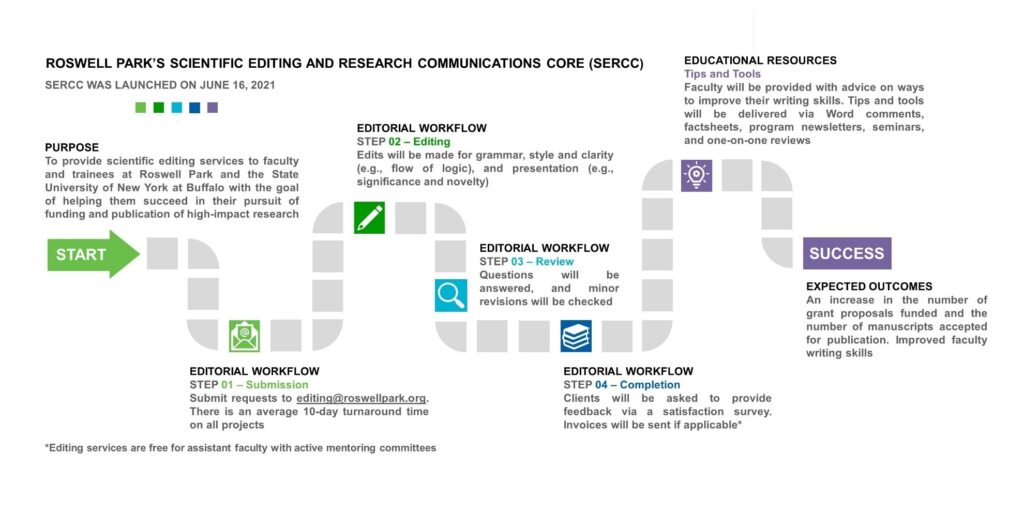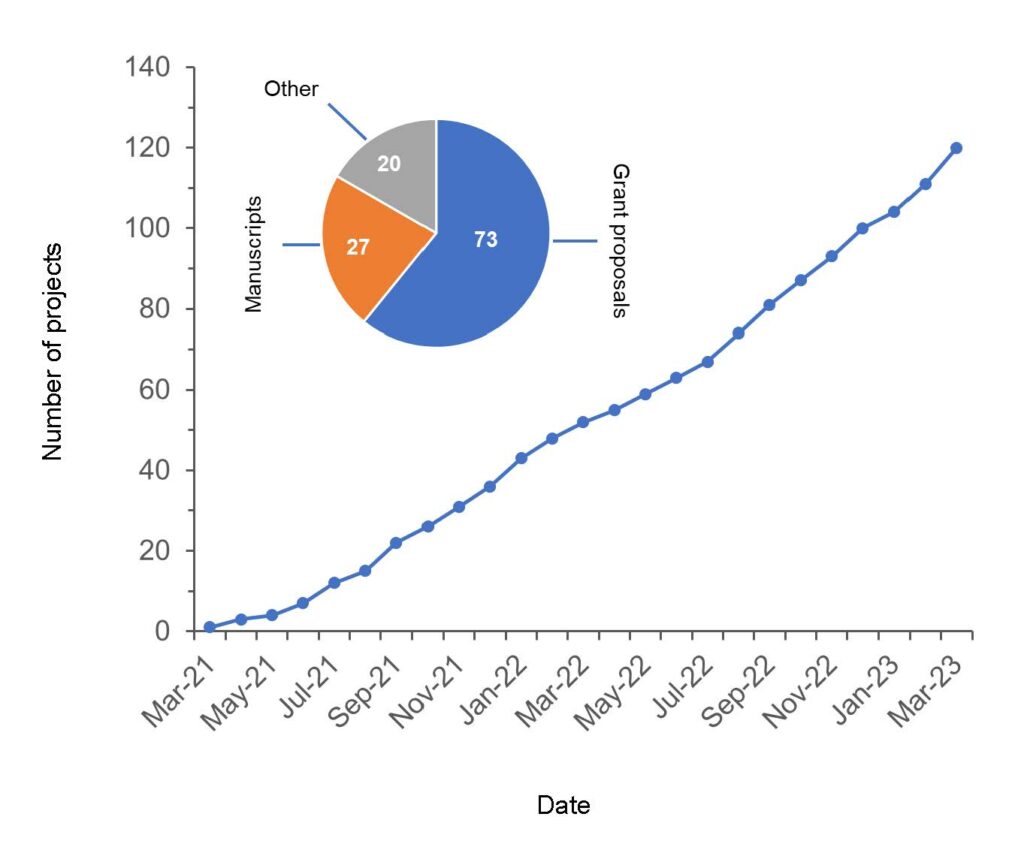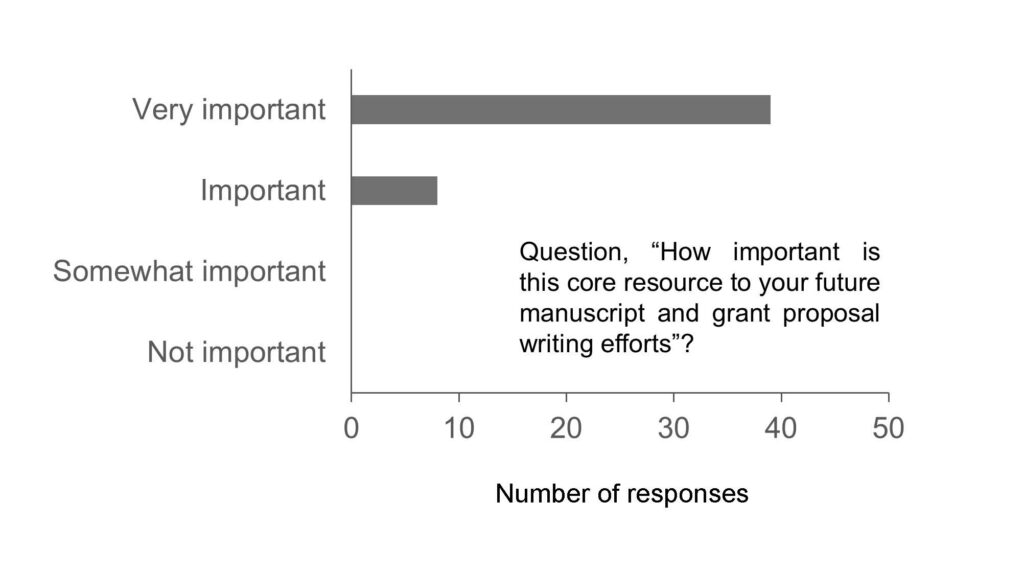Introduction
Science editors play an important role in ensuring the integrity of the scientific literature. While journal editors work with authors to improve the clarity and conciseness of manuscripts during the submission, peer review, and publication stages,1 inclusion of professional editors for authors early on during scholarly knowledge production also can be of high value. Specifically, author editors can provide authors with substantial editing support and customized educational resources that have the potential to improve faculty writing skills, boost their productivity, and enhance efficiency at later publication stages. Reports from various medical institutions on the use of such science editors are generally positive.2–6 However, shared experiences with these types of integrated editing–educational interventions targeted at faculty are scarce in the literature. Hence, this topic remains an underreported area of science communications that would benefit from further evaluation and discussion among all professionals involved in the knowledge production pipeline.
This article provides a summary of 10 lessons learned from implementing a formal science editing program at Roswell Park Comprehensive Cancer Center in Buffalo, NY—this information was presented earlier in the form of a poster at the 2023 CSE meeting in Toronto, Canada. Roswell Park, founded in 1898, is a National Cancer Institute (NCI)-designated comprehensive cancer center, with approximately 400 faculty who are engaged in basic science and translational, clinical, and population-based research. The editing program, formally called the Scientific Editing and Research Communications Core (SERCC) Resource, was conceptualized following a needs assessment by the Faculty Development Program and Grants Office in 2020, in which mechanisms to improve writing skills of early career faculty were deemed of high priority. Funding for SERCC is being provided by institutional support. Useful models during the program conceptualization and design phases included the University of Iowa’s SERCC and University of Maryland Baltimore’s Writing Center. Timewise, the editing program was designed in the spring of 2021 and launched later that summer; now, in the summer of 2023, the program has been in operation for 2 years. The editing program currently operates under Roswell Park’s Shared Resources management infrastructure, as an institutionally supported resource, and Roswell Park’s SERCC has a website that is publicly available.7
The primary activities in SERCC include the editing of manuscripts and grant proposals for early career faculty and EAL (English as an additional language) authors at Roswell Park and the State University of New York at Buffalo, and the development of educational resources. The editing workflow requires a 10-day turnaround time (Figure 1). Educational resources are delivered through comments in edited files, summary reports, educational factsheets distributed through an internal employee internet portal, quarterly program newsletters, and scientific communication seminars. Besides these primary activities, biannual program evaluations are used to review performance and outcome metrics—one important performance benchmark is no unsatisfied clients, and client satisfaction is assessed approximately 1 week after the completion of each project. Outreach and marketing activities to new faculty are conducted under the auspices of the Shared Resource Management Office, through which new faculty are introduced to SERCC during orientation, introductory emails, shared resource newsletters, and a shared resource guidebook. Department chairs also have played a pivotal role in promoting the editing resource to faculty. Lastly, occasional work with graduate students occurs in the form of class lectures and writing workshops; however, SERCC does not edit theses or dissertations.

Lessons Learned
A “lessons learned” approach can serve as a powerful intellectual framework for evaluating programs and sharing best practices. Useful examples of the application of this approach to programs aimed at improving faculty writing skills in medical settings exist.3,8,9 Here, we offer 10 lessons learned from the first 2 years of implementation of SERCC at Roswell Park. These lessons are shared with the hope that the information will benefit other science editors who work in collaboration with faculty development and research development programs; equally, we aim to raise awareness about the science editing taking place early on during scholarly knowledge production. These author editors are well positioned to implement author skills building initiatives on topics of importance to journal editors. The 10 lessons learned are as follows:
- Lesson 1: Many faculty were not familiar with professional editing services. In an August 2021 newsletter poll, we asked our readership (which was composed of faculty, postdoctoral fellows, and graduate students) “have you ever used a professional editing service before?” The majority of respondents had not (yes, 13%; no, 87%; n = 15). Personal communications also have corroborated the novelty of professional editing services to our faculty. Thus, our outreach on the educational and career benefits of editing was likely important to the program’s success.
- Lesson 2: Editing services have been particularly beneficial for new faculty and EAL authors. This was evidenced by improvements in writing quality over time for repeat clients (as assessed through qualitative observations) and new funding secured by faculty, albeit any editing-related enhancements (e.g., improved language quality) are only one factor that contributes to funding successes.
- Lesson 3: There has been sustained demand for in-house editorial services (Figure 2). The busiest times have corresponded to 4–6 weeks prior to the grant cycle deadlines at the National Institutes of Health and U.S. Department of Defense. Variation in demand is likely unavoidable throughout the year, and planned limitations on non-editorial work for busy time periods can help programs accommodate these peaks in demand.
- Lesson 4: Plain language summaries are difficult for academic scientists to write. Heavy editing will almost always be needed when working with plain language text. Hence, a good practice is to encourage clients to supply any required plain language summaries upfront with the bulk of their projects so that this type of text is not delegated to work done at the last minute.
- Lesson 5: Building trust upfront is important. Programs need to consider the most suitable ways to build trust with new clients, for example, by offering free sample edits, ensuring the integrity of the edit, supplying edits as recommendations not mandates, maintaining the author’s voice, and raising the visibility of editors through seminars and meetings. The most fruitful solutions will likely be context dependent.
- Lesson 6: Variability exists in needs for editing support (copy edits vs. content edits, improvements for clarity and logic). Because of variability in writing quality among faculty, built-in contingency time for each project is helpful. SERCC uses a 10-day turnaround time on all projects greater than 3 pages in length. In a few instances, 10 days was found to be excessive, but the clients were very happy to receive their edits back early; conversely, in a few instances, more than 10 days would have been desirable, and the editing work had to be prioritized to the most salient issues in need of attention. In general, we have found that a consistent 10-day turnaround time is optimal and easy to implement.
- Lesson 7: Educational outreach on common mistakes is an important mechanism for improving writing quality. Outreach can be delivered through various mechanisms, such as Word tips, educational factsheets, and seminars. Tailored educational support is one feature that makes these types of in-house editing programs so worthwhile.
- Lesson 8: Turnaround times are an important barrier to wider use of the editing resource. Rush edits are often desired but unrealistic. Authors in need of rush edits can be referred to external editing services.
- Lesson 9: Grant writing is different from manuscript writing. While new faculty typically excel at the latter, educational and substantial editing support (vs. simple copy editing support) are needed for the former. Thus, the time needed for editing will typically be higher for grant proposals than manuscripts. Presentation tips for grants can be especially valuable, such as the need to use a good lede and keywords, and ways to improve the significance and novelty statements.
- Lesson 10: Faculty have consistently reported that the editing resource is important to their scholarship (Figure 3). The monitoring of faculty sentiment is important for program planning purposes and ultimately leadership support and program sustainability.


Conclusions
The main takeaways of this reflective analysis are threefold. First, intuitively, there is value in including science editors early on during knowledge production at academic medical institutions. Importantly, these editors can offer authors editing and educational support that would be cost-prohibitive for journals, with long-term benefits in terms of improved writing skills, increased productivity, and downstream publication efficiencies. However, further metric monitoring and program evaluations will be necessary to quantitatively assess the value going forward. We are currently collecting data through client satisfaction surveys and assessing project outcomes (i.e., number of grants funded and manuscripts accepted for publication) to help us better understand the programmatic value of SERCC. In the future, we hope to interview early career and EAL authors who have used the editing services repeatedly to collect self-assessment data on writing quality improvements. Any such links between in-house science editing programs and improvements in writing quality would be important to communicate. Further downstream benefits on aspects like DEI (diversity, equity, and inclusion) efforts and faculty retention are indeed possible (i.e., through successful experiences with grant writing and high-impact publications) but would be very difficult to quantify.
Second, editing support is best delivered through a formal, integrated editing–educational framework, with ample time for commenting and review, through which authors have opportunities to learn from errors and improve their writing skills. While some authors and editors may already view editing as having educational value,6,10–12 to truly offer editing services as a meaningful didactical experience at medical institutions, the authors should be made aware upfront that they are expected to show a desire to learn from the edits and corresponding editorial comments. Edits should not be completed at the last minute if possible. Through comments and summary reports, authors can be introduced to reputable style manuals, such as the American Medical Association’s AMA Manual of Style and CSE’s Scientific Style and Format, so that they become capable of correcting problematic text independently in the future. Additionally, repeat clients should be assessed for improvements in writing quality over the long-term; in our experience, several early career and EAL faculty have achieved such performance improvements, and this represents one of the most rewarding parts of working in SERCC. However, application of appropriate tools and metrics to assess writing quality improvements following the editing intervention would be worthwhile and add necessary rigor to this supposition.
Third, growth in the number of in-house science editing programs, and the sharing of knowledge on existing ones, would be desirable. Given the high potential benefits of in-house science editing, namely, improvements in faculty writing skills and productivity, and enhancements in efficiency at later publication stages, increased availability of these types of programs at academic medical centers is predicted in the future. Notably, with in-house editorial services, controls (e.g., hiring and training of editors, quality assurance processes) can be implemented easily to ensure that the editing work is consistently of high quality, and confidentiality is guaranteed; authors can be referred to external editorial services if they need a rush edit on a manuscript or the program is temporarily exceeding capacity. Future sharing of best practices and data on the educational value and returns on investment for these types of programs would help to advance the field. We encourage authors who are interested in obtaining this type of editorial support to reach out to their institution’s faculty development and research development programs—informal editing mechanisms may already exist, and if not, the expression of interest could lead to the development of new editing programs in the future.
Our programmatic success at Roswell Park, as indicated by sustained demand for editing services (Figure 2) and positive faculty sentiment (Figure 3), has been driven largely by the good will of faculty and administrators; core values of excellence, professionalism, and respect; clear and efficient workflow processes; metrics to track performance; and use of the right mix between standardized policies (authors know what to expect) and flexibilities to deal with new situations in a young program. Future plans include expansion of the metrics being monitored to include utilization rates (number of projects edited in relation to the total number submitted during a particular time period) among junior faculty, detailed analyses of turnaround times to find ways to improve efficiency, and wider dissemination of our educational resources.
Acknowledgments
The authors thank conference attendees at the 2023 CSE meeting and Dr Mukund Seshadri of Roswell Park for useful discussions that improved this paper. This work was supported by Roswell Park Comprehensive Cancer Center and National Cancer Institute grant P30CA016056. Additional funding was provided by the Roswell Park Alliance Foundation.
References and Links
- Jakubisin J, Inman KS. The scientific editor: an advocate for transparent research. Sci Ed. 2023;46:11–13.
- Barroga E, Mitoma H. Improving scientific writing skills and publishing capacity by developing university-based editing system and writing programs. J Korean Med Sci. 2019;34:e9.
- Havermahl T, LaPensee E, Williams D, Clauw D, Parker RA, Downey B, Liu J, Myles J. Model for a university-based clinical research development infrastructure. Acad Med. 2015;90:47–52.
- Clark C, Sullivan B. Evaluating the NIH library editing service: pilot study used to analyze service impact. Sci Technol Libr. 2014;33:351–357.
- Cameron C, Deming SP, Notzon B, Cantor SB, Broglio KR, Pagel W. Scientific writing training for academic physicians of diverse language backgrounds. Acad Med. 2009;84:505–510.
- Stephens PA, Campbell JM. Scientific writing and editing: a new role for the library. Bull Med Libr Assoc. 1995;83:478–482.
- https://www.roswellpark.org/shared-resources/scientific-editing-research-communications-core
- Childs E, Remein CD, Bhasin RM, Harris AC, Day A, Sullivan LM, Coleman DL, Benjamin EJ. How to launch and continually enhance an effective medical campus faculty development program: steps for implementation and lessons learned. J Healthc Leadersh. 2021;13:147–156.
- Pololi L, Knight S, Dunn K. Facilitating scholarly writing in academic medicine. J Gen Intern Med. 2004;19:64–68.
- Harwood N. ‘Teaching the writer to fish so they can fish for the rest of their lives’: lecturer, English language tutor, and student views on the educative role of proofreading. Engl Specif Purp. 2022;68:116–130.
- Mišak A, Marušić M, Marušić A. Manuscript editing as a way of teaching academic writing: experience from a small scientific journal. J Second Lang Writ. 2005;14:122–131.
- Wisker G. Articulate – academic writing, refereeing, editing and publishing our work in learning, teaching and educational development. Innov Educ Teach Int. 2013;50:344–356.
Deanna E Conners, MS, PhD (https://orcid.org/0000-0001-9717-0871), is Senior Science Editor, Director, Scientific Editing and Research Communications Core (SERCC) Resource, Roswell Park Comprehensive Cancer Center. Jamie L Brooks, MBA, is SERCC Program Manager, Faculty Development Coordinator, Roswell Park Comprehensive Cancer Center. Judith G. Epstein, MS, is Cancer Center Support Grant Administrator, Director, Grants and Foundation Development, Roswell Park Comprehensive Cancer Center. Sandra O. Gollnick, PhD (https://orcid.org/0000-0001-6493-9306), is Professor Emeritus, Roswell Park Comprehensive Cancer Center.
Opinions expressed are those of the authors and do not necessarily reflect the opinions or policies of the Council of Science Editors or the Editorial Board of Science Editor.
